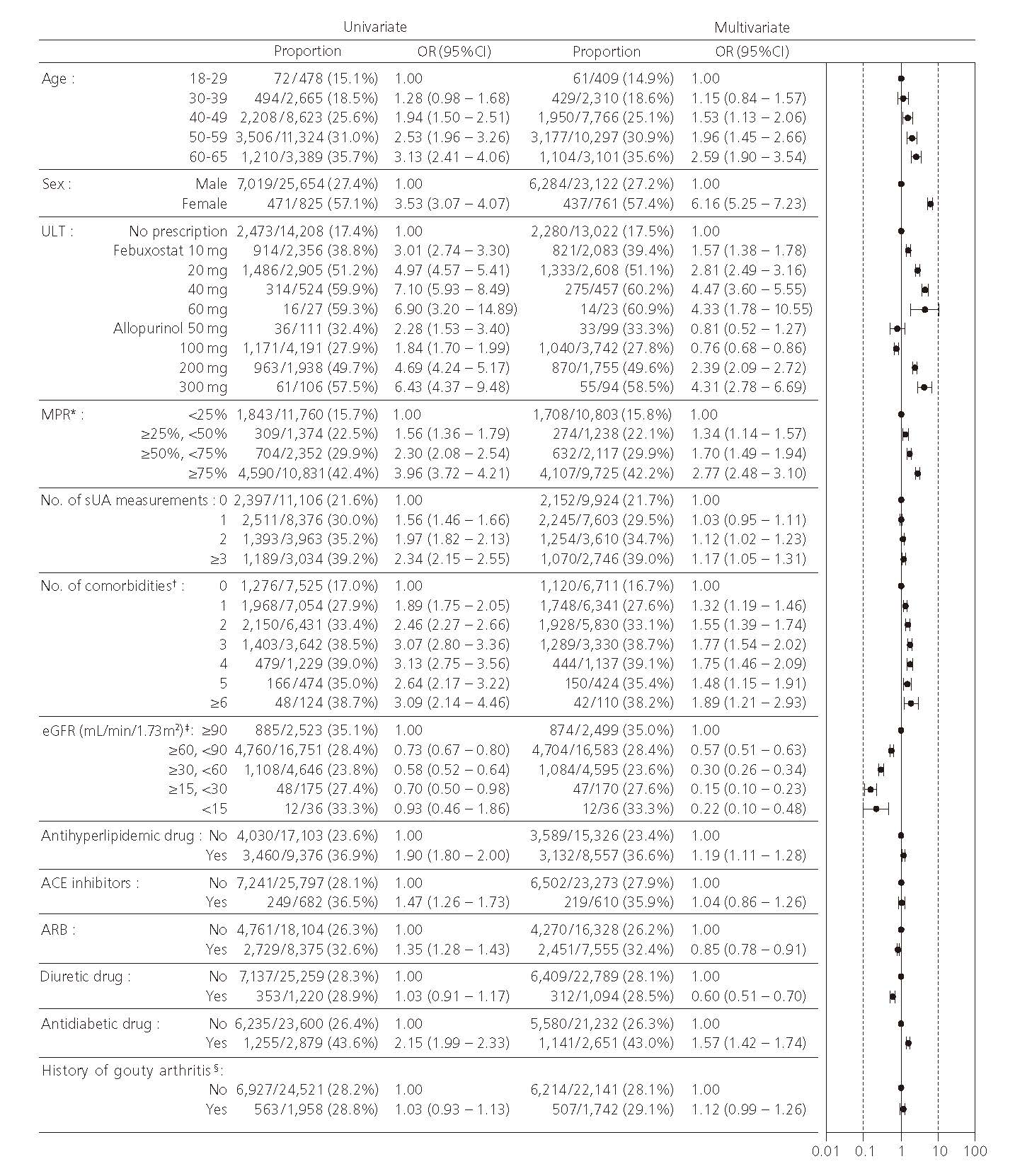Session Information
Date: Tuesday, November 12, 2019
Title: Epidemiology & Public Health Poster III: OA, Gout, & Other Diseases
Session Type: Poster Session (Tuesday)
Session Time: 9:00AM-11:00AM
Background/Purpose: The number of gout attacks can be reduced by achieving and maintaining serum uric acid (sUA) at or below 6.0 mg/dL, a level uniformly recommended by international guidelines. However, although urate-lowering therapy (ULT) can reliably achieve such reductions, many gout patients fail to reach their sUA target, and such patients tend to experience recurring gouty arthritis in real-world clinical practice. The present study assessed factors related to achieving target sUA levels and the occurrence of gouty arthritis in Japanese clinical practice, to better understand the underlying reasons for suboptimal treatment of gout.
Methods: We analyzed Japanese health insurance claims and medical check-up data from April 2016 to March 2017, and assessed factors that were associated with target sUA in gout and asymptomatic hyperuricemia and with the occurrence of gouty arthritis in gout. We also conducted subgroup analysis of ULT prescriptions and outcomes, stratified by renal function, to determine effects on achieving target sUA. Data were obtained from the JMDC Claims Database, including diagnostic codes, names of prescription drugs prescribed, and data from physical examinations of company employees and their dependents.
Results: Patients who reached their target sUA tended to be older, to be female, to receive higher doses of ULT, to achieve higher treatment adherence ( medication possession ratio), to have more comorbidities, and/or to be prescribed antidiabetic drugs. We found that renal dysfunction and/or diuretic prescriptions were predictive of reduced achievement of target sUA. This was obvious in severe renal dysfunction (OR 0.22 [95% CI 0.10-0.48] for < 15 and 0.15 [0.10-0.23] for ≥15 to < 30, compared with eGFR ≥90 mL/min/1.73m2) (Figure 1). Notably, the mean prescribed ULT dose was low (febuxostat 17.0-21.0 mg/day, allopurinol 123.1-139.6 mg/day) a cross all renal function categories. We also found that lower renal function was associated with lower achievement of target sUA for every ULT dosage category. Our data showed that gouty arthritis attacks occurred more often among patients with a prior history of gouty arthritis and less often in patients who had higher ULT adherence, sUA measured at medical facilities, and/or more comorbidities (Figure 2).
Conclusion: Our analysis showed renal dysfunction as an important predictor for failure to achieve target sUA; within our dataset, most renal dysfunction patients with gout or asymptomatic hyperuricemia did not reach target sUA. These findings imply suboptimal disease management, especially in this population. Our findings also suggested the importance of regular clinic visits and sustained adherence to ULT in the control of gouty arthritis attacks.

FactorsinAchievingSerumUricAcid_fig1
The forest plot shows the point estimate and 95% confidence interval for the odds ratio in multivariate analysis.
The objective variable was whether target sUA -6.0 mg/dL or below- had been achieved by the time of the medical check-up, and the explanatory variables were from data on sUA measurements during the 6-month period prior to the medical check-up.
* MPR = Number of days ULT was prescribed from April 1, 2016 to March 31, 2017 / 365 days from April 1, 2016 to March 31, 2017
† Comorbidities: hypertension, type 2 diabetes, ischemic heart disease, heart failure, cerebrovascular disease, hyperlipidemia, renal dysfunction
‡eGFR was calculated using the following formula. eGFR -male- = 194×sCr-1.094×age-0.287, eGFR -female- = 194×sCr-1.094×age-0.287×0.739
§ The most recent 6 months prior to the study period.
OR, odds ratio; ULT, urate-lowering therapy; MPR, medication possession ratio; sUA, serum uric acid; eGFR, estimated glomerular filtration rate; ACE, angiotensin converting enzyme; ARB, angiotensin II receptor blocker.

FactorsinAchievingSerum UricAcid_fig2
The forest plot shows the point estimate and 95% confidence interval for the odds ratio in multivariate analysis.
The objective variable was whether gouty arthritis occurred between April 2016 and March 2017, and the explanatory variables were from data during the 6-month period between October 2015 and March 2016.
* MPR = Number of days ULT was prescribed from April 1, 2016 to March 31, 2017 / 365 days from April 1, 2016 to March 31, 2017
† Comorbidities: hypertension, type 2 diabetes, ischemic heart disease, heart failure, cerebrovascular disease, hyperlipidemia, renal dysfunction
‡ The most recent 6 months prior to the study period.
OR, odds ratio; ULT, urate-lowering therapy; MPR, medication possession ratio; Feb, febuxostat; Allo, allopurinol; sUA, serum uric acid ACE, angiotensin converting enzyme; ARB, angiotensin II receptor blocker.
To cite this abstract in AMA style:
Koto R, Nakajima A, Horiuchi H, Yamanaka H. Factors in Achieving Serum Uric Acid Target and the Occurrence of Gouty Arthritis: A Cross-sectional Study Based on Japanese Health Insurance Claim Data [abstract]. Arthritis Rheumatol. 2019; 71 (suppl 10). https://acrabstracts.org/abstract/factors-in-achieving-serum-uric-acid-target-and-the-occurrence-of-gouty-arthritis-a-cross-sectional-study-based-on-japanese-health-insurance-claim-data/. Accessed .« Back to 2019 ACR/ARP Annual Meeting
ACR Meeting Abstracts - https://acrabstracts.org/abstract/factors-in-achieving-serum-uric-acid-target-and-the-occurrence-of-gouty-arthritis-a-cross-sectional-study-based-on-japanese-health-insurance-claim-data/
